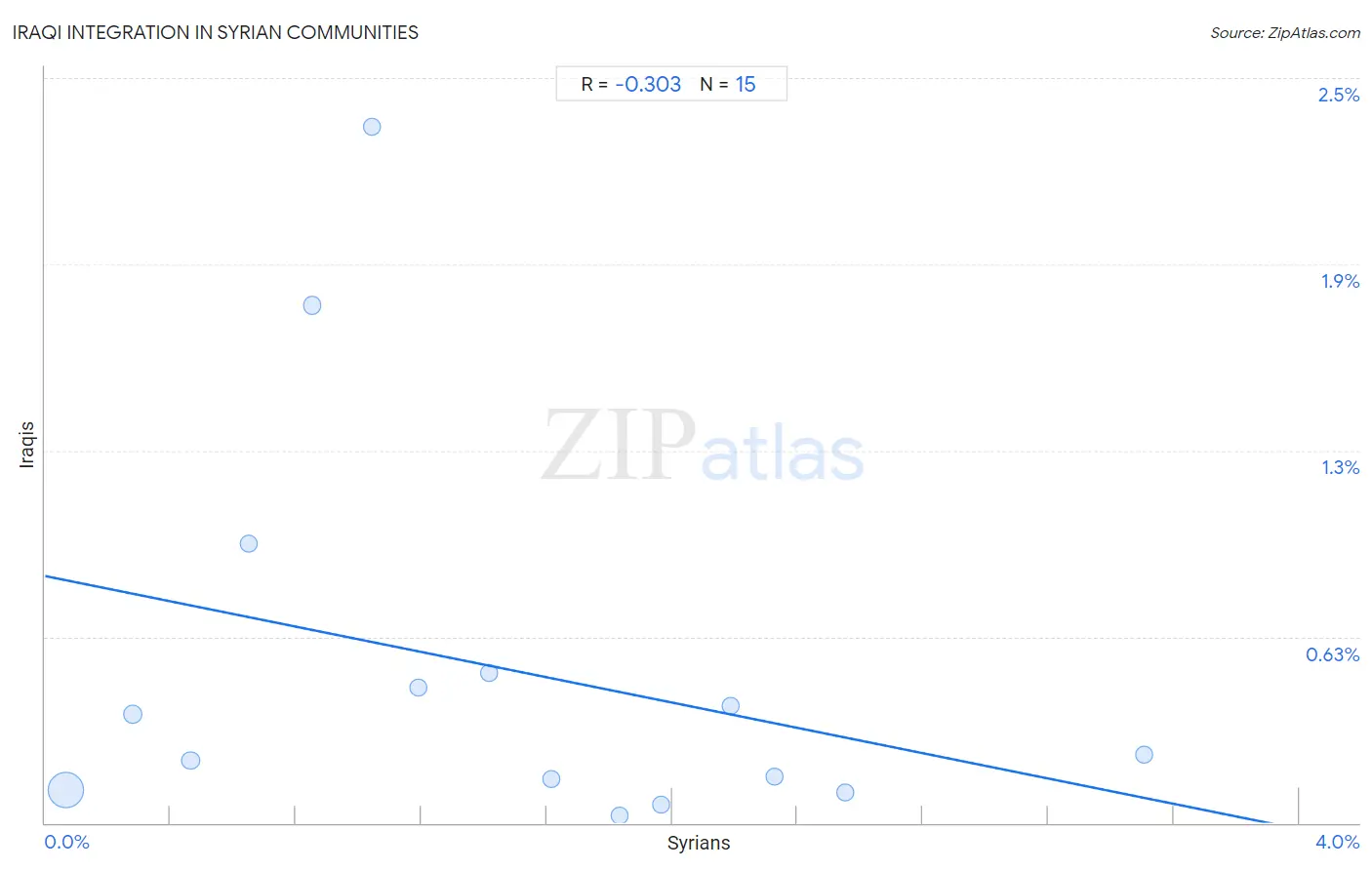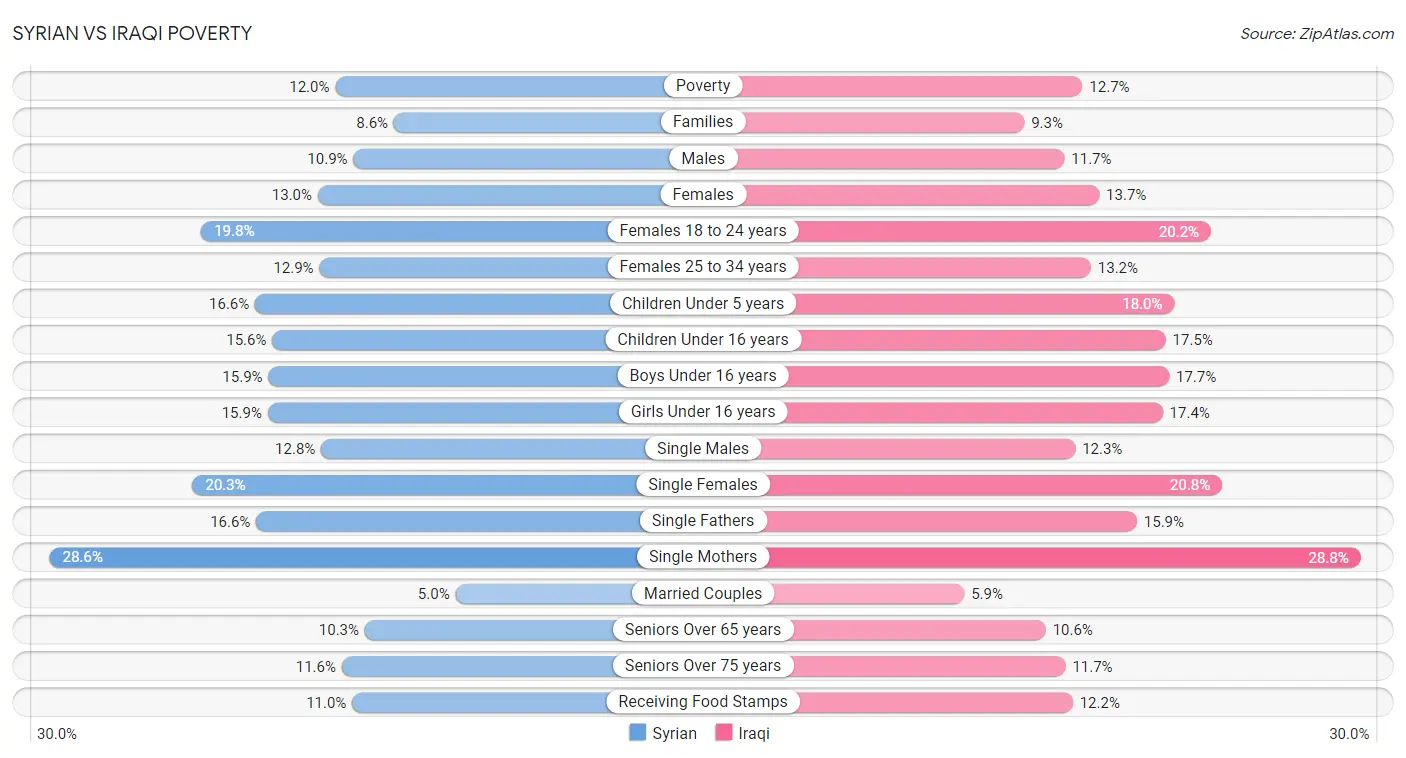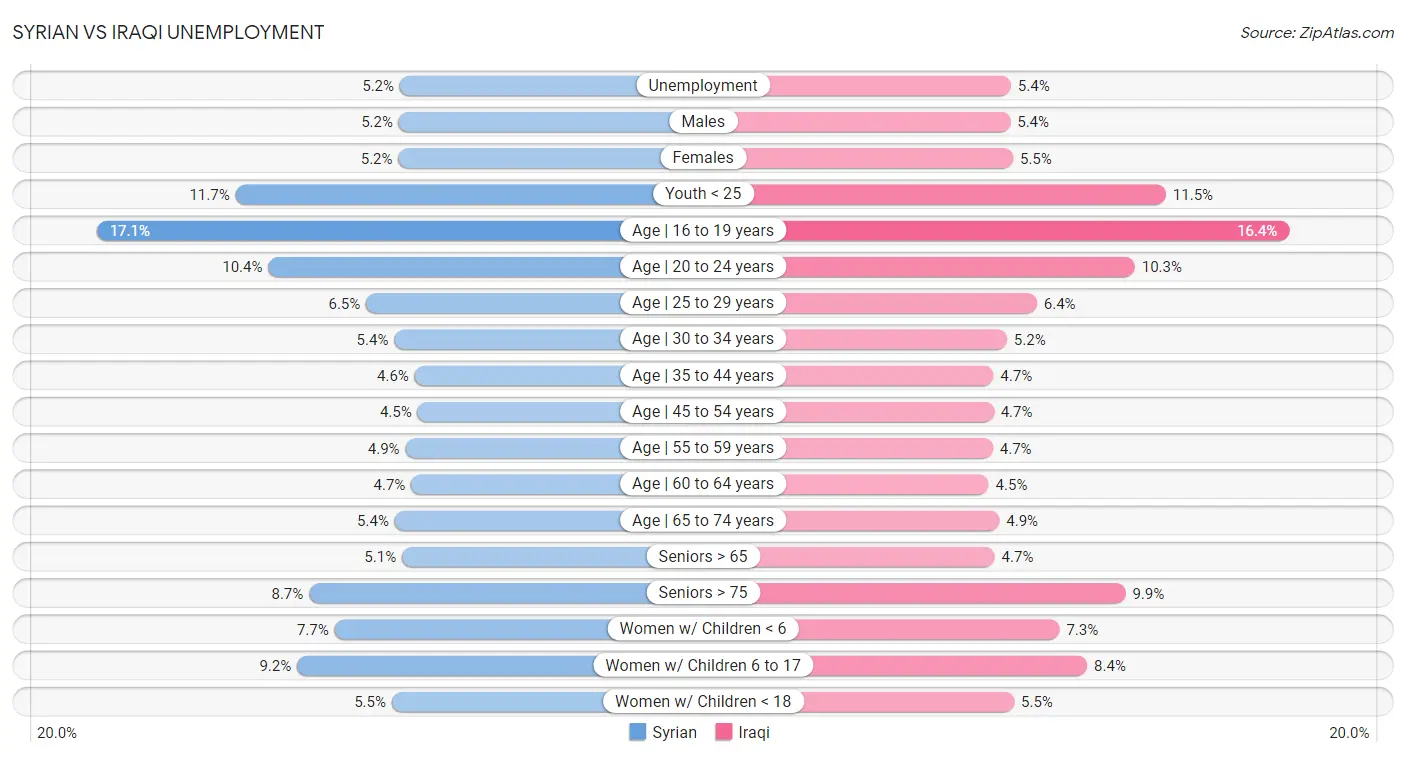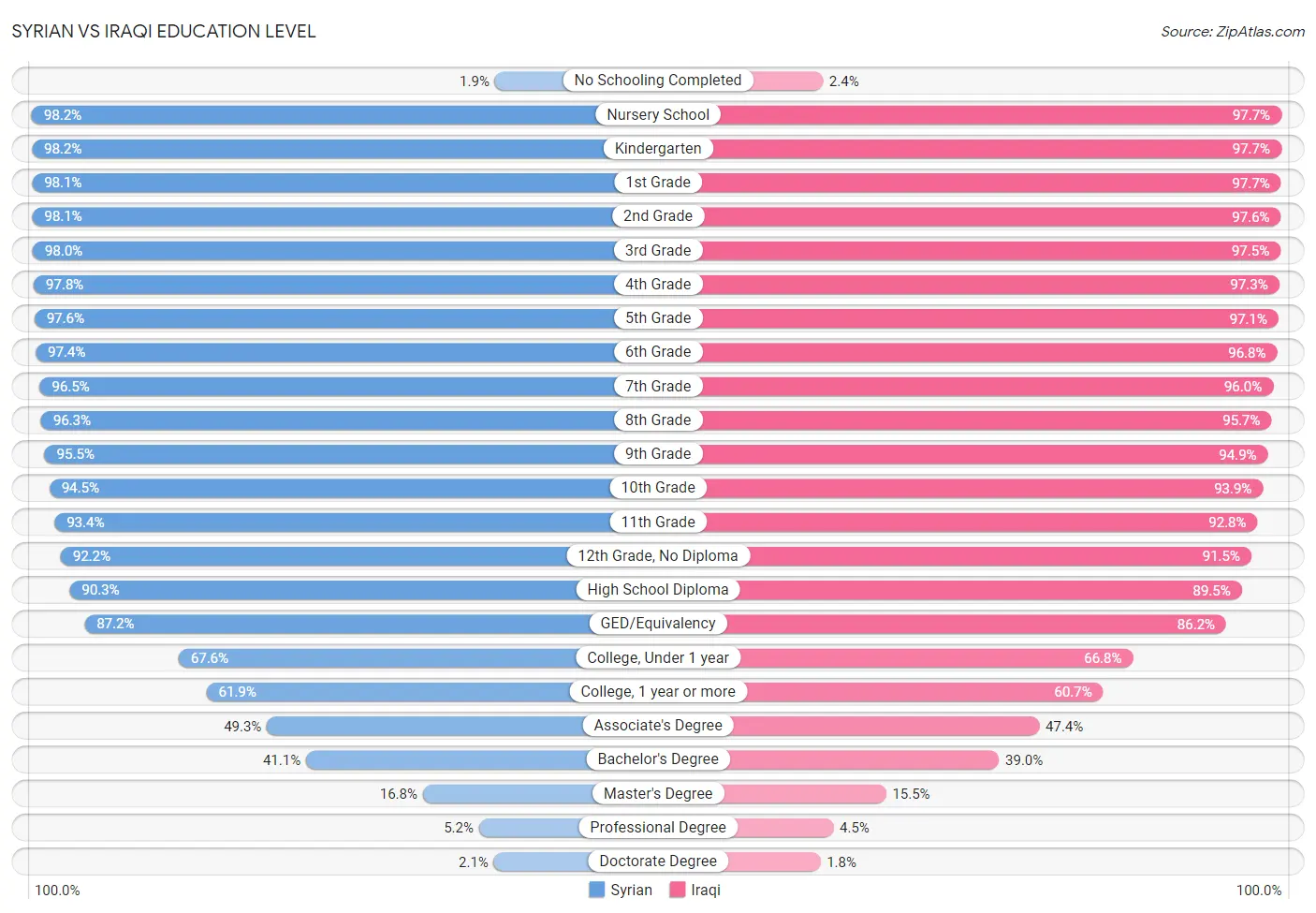Syrian vs Iraqi Community Comparison
COMPARE
Syrian
Iraqi
Social Comparison
Social Comparison
Syrians
Iraqis
7,975
SOCIAL INDEX
77.2/ 100
SOCIAL RATING
97th/ 347
SOCIAL RANK
5,167
SOCIAL INDEX
49.2/ 100
SOCIAL RATING
183rd/ 347
SOCIAL RANK
Iraqi Integration in Syrian Communities
The statistical analysis conducted on geographies consisting of 134,630,617 people shows a mild negative correlation between the proportion of Iraqis within Syrian communities in the United States with a correlation coefficient (R) of -0.303. On average, for every 1% (one percent) increase in Syrians within a typical geography, there is a decrease of 0.212% in Iraqis. To illustrate, in a geography comprising of 100,000 individuals, a rise of 1,000 Syrians corresponds to a decrease of 212.4 Iraqis.

Syrian vs Iraqi Income
When considering income, the most significant differences between Syrian and Iraqi communities in the United States are seen in per capita income ($46,837 compared to $42,760, a difference of 9.5%), householder income ages 25 - 44 years ($99,215 compared to $90,764, a difference of 9.3%), and median family income ($109,299 compared to $100,658, a difference of 8.6%). Conversely, both communities are more comparable in terms of householder income under 25 years ($51,353 compared to $50,802, a difference of 1.1%), wage/income gap (27.6% compared to 26.6%, a difference of 3.5%), and householder income over 65 years ($63,494 compared to $60,466, a difference of 5.0%).

| Income Metric | Syrian | Iraqi |
| Per Capita Income | Exceptional $46,837 | Fair $42,760 |
| Median Family Income | Exceptional $109,299 | Fair $100,658 |
| Median Household Income | Exceptional $89,830 | Fair $83,753 |
| Median Earnings | Exceptional $48,934 | Fair $46,140 |
| Median Male Earnings | Exceptional $58,187 | Average $54,182 |
| Median Female Earnings | Excellent $40,727 | Poor $38,666 |
| Householder Age | Under 25 years | Poor $51,353 | Tragic $50,802 |
| Householder Age | 25 - 44 years | Exceptional $99,215 | Poor $90,764 |
| Householder Age | 45 - 64 years | Exceptional $107,207 | Fair $99,387 |
| Householder Age | Over 65 years | Exceptional $63,494 | Fair $60,466 |
| Wage/Income Gap | Tragic 27.6% | Poor 26.6% |
Syrian vs Iraqi Poverty
When considering poverty, the most significant differences between Syrian and Iraqi communities in the United States are seen in married-couple family poverty (5.0% compared to 5.9%, a difference of 16.8%), child poverty under the age of 16 (15.6% compared to 17.5%, a difference of 12.2%), and child poverty among boys under 16 (15.9% compared to 17.7%, a difference of 11.8%). Conversely, both communities are more comparable in terms of single mother poverty (28.6% compared to 28.8%, a difference of 1.0%), seniors poverty over the age of 75 (11.6% compared to 11.7%, a difference of 1.0%), and female poverty among 18-24 year olds (19.8% compared to 20.2%, a difference of 2.1%).

| Poverty Metric | Syrian | Iraqi |
| Poverty | Good 12.0% | Fair 12.7% |
| Families | Excellent 8.6% | Fair 9.3% |
| Males | Good 10.9% | Poor 11.7% |
| Females | Good 13.0% | Fair 13.7% |
| Females 18 to 24 years | Excellent 19.8% | Average 20.2% |
| Females 25 to 34 years | Exceptional 12.9% | Good 13.2% |
| Children Under 5 years | Good 16.6% | Poor 18.0% |
| Children Under 16 years | Good 15.6% | Tragic 17.5% |
| Boys Under 16 years | Good 15.9% | Tragic 17.7% |
| Girls Under 16 years | Good 15.9% | Poor 17.4% |
| Single Males | Average 12.8% | Exceptional 12.3% |
| Single Females | Exceptional 20.3% | Good 20.8% |
| Single Fathers | Poor 16.6% | Exceptional 15.9% |
| Single Mothers | Excellent 28.6% | Good 28.8% |
| Married Couples | Good 5.0% | Tragic 5.9% |
| Seniors Over 65 years | Exceptional 10.3% | Excellent 10.6% |
| Seniors Over 75 years | Exceptional 11.6% | Excellent 11.7% |
| Receiving Food Stamps | Excellent 11.0% | Fair 12.2% |
Syrian vs Iraqi Unemployment
When considering unemployment, the most significant differences between Syrian and Iraqi communities in the United States are seen in unemployment among seniors over 75 years (8.7% compared to 9.9%, a difference of 13.3%), unemployment among women with children ages 6 to 17 years (9.2% compared to 8.4%, a difference of 9.9%), and unemployment among ages 65 to 74 years (5.4% compared to 4.9%, a difference of 8.8%). Conversely, both communities are more comparable in terms of unemployment among women with children under 18 years (5.5% compared to 5.5%, a difference of 0.56%), unemployment among ages 20 to 24 years (10.4% compared to 10.3%, a difference of 0.79%), and unemployment among youth under 25 years (11.7% compared to 11.5%, a difference of 1.3%).

| Unemployment Metric | Syrian | Iraqi |
| Unemployment | Good 5.2% | Poor 5.4% |
| Males | Good 5.2% | Fair 5.4% |
| Females | Good 5.2% | Tragic 5.5% |
| Youth < 25 | Fair 11.7% | Good 11.5% |
| Age | 16 to 19 years | Excellent 17.1% | Exceptional 16.4% |
| Age | 20 to 24 years | Fair 10.4% | Average 10.3% |
| Age | 25 to 29 years | Excellent 6.5% | Exceptional 6.4% |
| Age | 30 to 34 years | Good 5.4% | Exceptional 5.2% |
| Age | 35 to 44 years | Excellent 4.6% | Average 4.7% |
| Age | 45 to 54 years | Good 4.5% | Tragic 4.7% |
| Age | 55 to 59 years | Tragic 4.9% | Exceptional 4.7% |
| Age | 60 to 64 years | Exceptional 4.7% | Exceptional 4.5% |
| Age | 65 to 74 years | Average 5.4% | Exceptional 4.9% |
| Seniors > 65 | Excellent 5.1% | Exceptional 4.7% |
| Seniors > 75 | Average 8.7% | Tragic 9.9% |
| Women w/ Children < 6 | Fair 7.7% | Exceptional 7.3% |
| Women w/ Children 6 to 17 | Tragic 9.2% | Exceptional 8.4% |
| Women w/ Children < 18 | Average 5.5% | Fair 5.5% |
Syrian vs Iraqi Labor Participation
When considering labor participation, the most significant differences between Syrian and Iraqi communities in the United States are seen in in labor force | age 16-19 (37.6% compared to 38.6%, a difference of 2.7%), in labor force | age 20-24 (75.0% compared to 76.0%, a difference of 1.2%), and in labor force | age 30-34 (84.8% compared to 83.8%, a difference of 1.1%). Conversely, both communities are more comparable in terms of in labor force | age 20-64 (79.6% compared to 79.3%, a difference of 0.31%), in labor force | age 45-54 (82.6% compared to 82.2%, a difference of 0.39%), and in labor force | age 35-44 (84.2% compared to 83.8%, a difference of 0.51%).

| Labor Participation Metric | Syrian | Iraqi |
| In Labor Force | Age > 16 | Average 65.0% | Exceptional 65.7% |
| In Labor Force | Age 20-64 | Average 79.6% | Poor 79.3% |
| In Labor Force | Age 16-19 | Exceptional 37.6% | Exceptional 38.6% |
| In Labor Force | Age 20-24 | Average 75.0% | Exceptional 76.0% |
| In Labor Force | Age 25-29 | Good 84.8% | Tragic 83.9% |
| In Labor Force | Age 30-34 | Good 84.8% | Tragic 83.8% |
| In Labor Force | Age 35-44 | Fair 84.2% | Tragic 83.8% |
| In Labor Force | Age 45-54 | Fair 82.6% | Tragic 82.2% |
Syrian vs Iraqi Family Structure
When considering family structure, the most significant differences between Syrian and Iraqi communities in the United States are seen in births to unmarried women (30.2% compared to 27.6%, a difference of 9.5%), family households with children (27.8% compared to 28.5%, a difference of 2.6%), and single mother households (6.0% compared to 6.1%, a difference of 2.4%). Conversely, both communities are more comparable in terms of divorced or separated (11.7% compared to 11.8%, a difference of 0.090%), family households (64.5% compared to 64.4%, a difference of 0.29%), and currently married (47.5% compared to 46.9%, a difference of 1.3%).

| Family Structure Metric | Syrian | Iraqi |
| Family Households | Good 64.5% | Average 64.4% |
| Family Households with Children | Excellent 27.8% | Exceptional 28.5% |
| Married-couple Households | Exceptional 47.6% | Good 46.9% |
| Average Family Size | Tragic 3.19 | Good 3.24 |
| Single Father Households | Exceptional 2.2% | Exceptional 2.2% |
| Single Mother Households | Excellent 6.0% | Good 6.1% |
| Currently Married | Excellent 47.5% | Good 46.9% |
| Divorced or Separated | Exceptional 11.7% | Exceptional 11.8% |
| Births to Unmarried Women | Excellent 30.2% | Exceptional 27.6% |
Syrian vs Iraqi Vehicle Availability
When considering vehicle availability, the most significant differences between Syrian and Iraqi communities in the United States are seen in no vehicles in household (9.7% compared to 7.7%, a difference of 25.6%), 1 or more vehicles in household (90.3% compared to 91.9%, a difference of 1.8%), and 2 or more vehicles in household (56.2% compared to 57.1%, a difference of 1.6%). Conversely, both communities are more comparable in terms of 4 or more vehicles in household (6.3% compared to 6.2%, a difference of 0.50%), 3 or more vehicles in household (19.5% compared to 19.6%, a difference of 0.68%), and 2 or more vehicles in household (56.2% compared to 57.1%, a difference of 1.6%).

| Vehicle Availability Metric | Syrian | Iraqi |
| No Vehicles Available | Excellent 9.7% | Exceptional 7.7% |
| 1+ Vehicles Available | Excellent 90.3% | Exceptional 91.9% |
| 2+ Vehicles Available | Excellent 56.2% | Exceptional 57.1% |
| 3+ Vehicles Available | Average 19.5% | Average 19.6% |
| 4+ Vehicles Available | Average 6.3% | Fair 6.2% |
Syrian vs Iraqi Education Level
When considering education level, the most significant differences between Syrian and Iraqi communities in the United States are seen in no schooling completed (1.9% compared to 2.4%, a difference of 26.3%), professional degree (5.2% compared to 4.5%, a difference of 13.6%), and doctorate degree (2.1% compared to 1.8%, a difference of 13.0%). Conversely, both communities are more comparable in terms of kindergarten (98.2% compared to 97.7%, a difference of 0.45%), 3rd grade (98.0% compared to 97.5%, a difference of 0.45%), and nursery school (98.2% compared to 97.7%, a difference of 0.46%).

| Education Level Metric | Syrian | Iraqi |
| No Schooling Completed | Exceptional 1.9% | Tragic 2.4% |
| Nursery School | Exceptional 98.2% | Tragic 97.7% |
| Kindergarten | Exceptional 98.2% | Tragic 97.7% |
| 1st Grade | Exceptional 98.1% | Tragic 97.7% |
| 2nd Grade | Exceptional 98.1% | Tragic 97.6% |
| 3rd Grade | Exceptional 98.0% | Tragic 97.5% |
| 4th Grade | Exceptional 97.8% | Tragic 97.3% |
| 5th Grade | Exceptional 97.6% | Poor 97.1% |
| 6th Grade | Exceptional 97.4% | Poor 96.8% |
| 7th Grade | Exceptional 96.5% | Average 96.0% |
| 8th Grade | Exceptional 96.3% | Average 95.7% |
| 9th Grade | Exceptional 95.5% | Average 94.9% |
| 10th Grade | Exceptional 94.5% | Good 93.9% |
| 11th Grade | Exceptional 93.4% | Good 92.8% |
| 12th Grade, No Diploma | Exceptional 92.2% | Good 91.5% |
| High School Diploma | Exceptional 90.3% | Good 89.5% |
| GED/Equivalency | Exceptional 87.2% | Good 86.2% |
| College, Under 1 year | Exceptional 67.6% | Excellent 66.8% |
| College, 1 year or more | Exceptional 61.9% | Excellent 60.7% |
| Associate's Degree | Exceptional 49.3% | Good 47.4% |
| Bachelor's Degree | Exceptional 41.1% | Good 39.0% |
| Master's Degree | Exceptional 16.8% | Good 15.5% |
| Professional Degree | Exceptional 5.2% | Good 4.5% |
| Doctorate Degree | Exceptional 2.1% | Average 1.8% |
Syrian vs Iraqi Disability
When considering disability, the most significant differences between Syrian and Iraqi communities in the United States are seen in disability age under 5 (1.3% compared to 1.2%, a difference of 11.2%), disability age 65 to 74 (22.3% compared to 24.2%, a difference of 8.3%), and disability age 35 to 64 (11.0% compared to 11.5%, a difference of 5.2%). Conversely, both communities are more comparable in terms of hearing disability (3.1% compared to 3.1%, a difference of 0.030%), disability age 18 to 34 (6.6% compared to 6.7%, a difference of 0.50%), and ambulatory disability (6.0% compared to 6.1%, a difference of 0.81%).

| Disability Metric | Syrian | Iraqi |
| Disability | Average 11.7% | Fair 11.8% |
| Males | Average 11.2% | Fair 11.3% |
| Females | Good 12.1% | Fair 12.3% |
| Age | Under 5 years | Poor 1.3% | Exceptional 1.2% |
| Age | 5 to 17 years | Fair 5.6% | Average 5.6% |
| Age | 18 to 34 years | Average 6.6% | Fair 6.7% |
| Age | 35 to 64 years | Good 11.0% | Fair 11.5% |
| Age | 65 to 74 years | Exceptional 22.3% | Tragic 24.2% |
| Age | Over 75 years | Exceptional 46.7% | Tragic 48.6% |
| Vision | Excellent 2.1% | Good 2.1% |
| Hearing | Poor 3.1% | Poor 3.1% |
| Cognitive | Excellent 17.1% | Tragic 17.8% |
| Ambulatory | Good 6.0% | Good 6.1% |
| Self-Care | Average 2.5% | Tragic 2.6% |